Читать книгу Analysis and Control of Electric Drives - Ned Mohan - Страница 49
2‐6 ELECTRICAL ANALOGY
ОглавлениеAn analogy with electrical circuits can be very useful when analyzing mechanical systems. A commonly used analogy, though not a unique one, is to relate mechanical and electrical quantities, as shown in Table 2-2.
TABLE 2-2 Torque–Current Analogy
| Mechanical system | Electrical system |
| Torque (T) | Current (i) |
| Angular speed (ωm) | Voltage (v) |
| Angular displacement (θ) | Flux linkage (ψ) |
| Moment of inertia (J) | Capacitance (C) |
| Spring constant (K) | 1/Inductance (1/L) |
| Damping coefficient (B) | 1/Resistance (1/R) |
| Coupling ratio (nM/nL) | Transformer ratio (nL/nM) |
The coupling ratio is discussed later in this chapter.
For the mechanical system shown in Fig. 2-11, Fig. 2-12a shows the electrical analogy, where each inertia is represented by a capacitor from its node to a reference (ground) node. In this circuit, we can write equations similar to Eqs. (2-31) through (2-33). Assuming that the shaft is of infinite stiffness, the inductance representing it becomes zero, and the resulting circuit is shown in Fig. 2-12b, where ωm = ωM = ωL. The two capacitors representing the two inertias can now be combined to result in a single equation similar to Eq. (2-23).
